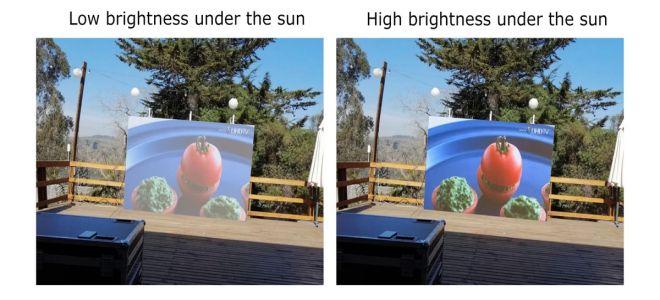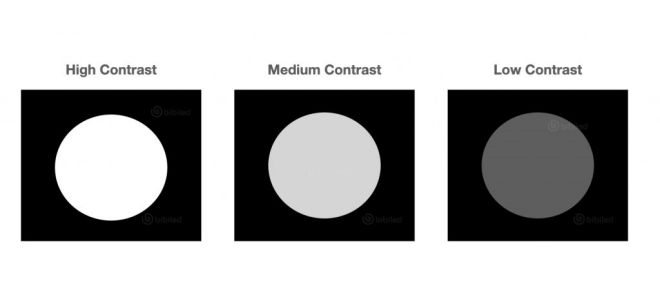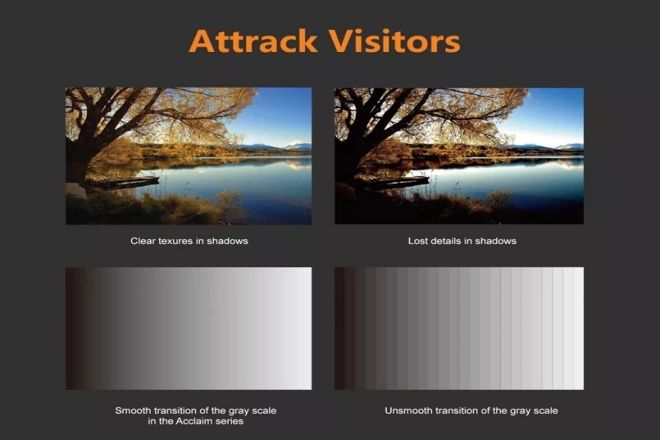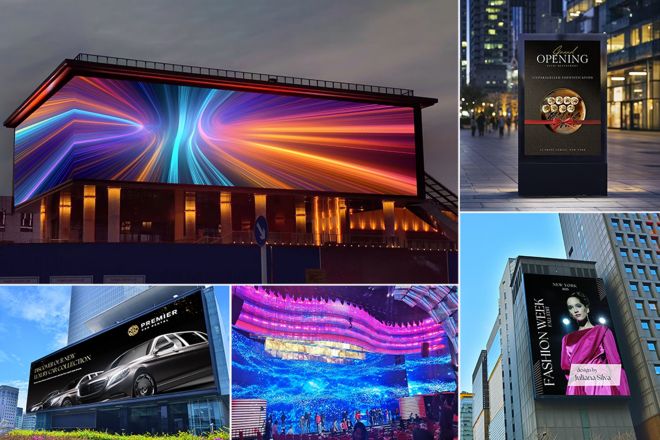Introduction

Among the performance indicators of Afficheurs LED, contrast is a crucial parameter. It is directly related to the display effect of the display screen and the visual experience of the audience.
An LED display with high contrast can present a more vivid and vivid image, making it easier for viewers to distinguish different elements in the picture and obtain a more realistic visual experience.
Therefore, this article will provide an in-depth explanation of the application and importance of contrast in LED displays. I hope it will be helpful to you.
1. Contrast definition

Contrast may sound technical, but it actually describes a very common visual phenomenon in our daily lives – the difference between light and dark in an image. You can imagine that when you walk from the sunny outdoors into the indoors, the contrasting feeling of bright and dark is a manifestation of contrast.
On an LED display, contrast refers to the brightness difference between the brightest part and the darkest part on the screen. Simply put, if there are bright whites and deep blacks in a picture, the picture will have a high contrast and look clearer and more vivid.
For LED displays, the importance of contrast is as indispensable as seasonings to a dish. It can greatly affect our visual experience when viewing screens. A high-contrast LED display is like a painting with bright colors and strong three-dimensional effects, which can bring us a more realistic and vivid visual experience.
It makes every detail in the image clearly visible, whether it is text, pictures, or videos; it can present the best display effect.
On the contrary, if the contrast of the LED display is not high enough, the images on the screen will appear blurry and lack a sense of hierarchy and three-dimensionality. You may find that some details are not clearly visible on the screen, which will greatly affect our viewing experience.
Therefore, whether in shopping malls, stadiums, or movie theaters, when we see those clear and bright LED displays, there is a silent effort in contrast behind them. It is it that makes our lives more colorful and our visual experience better. Therefore, when choosing an LED display, contrast is definitely a parameter that needs to be focused on.
There are many ways to calculate contrast; one of the commonly used formulas is:
Contrast = (brightest pixel value – darkest pixel value) / (brightest pixel value + darkest pixel value).
This formula works for grayscale images or color images that have been converted to grayscale, and the calculated contrast value is between [-1, 1]. For color images, the contrast of the RGB channels can be calculated separately and averaged as the contrast of the entire image.
In the actual application of LED display screens, the calculation of contrast is more specific. Usually, we consider the brightness distribution of the entire screen.
For example, if a screen has a brightness of 500cd/m² when in full white screen mode and 0.5cd/m² when in full black screen mode, then the contrast ratio of the screen is 1000:1. This means that when displaying white, the screen brightness is 1,000 times brighter than when displaying black, achieving a higher contrast effect.
2. The higher the contrast, the better
Higher contrast does not necessarily mean better; it needs to be judged based on specific application scenarios and personal needs.
Generally speaking, high contrast can indeed bring about a more vivid image effect so that the bright and dark parts of the image can be well displayed, thereby enhancing the realism and layering of the visual experience. When watching high-definition videos, playing games, or doing professional image design, high contrast can make the picture clearer and more detailed, helping users better capture details and distinguish colors.
However, a contrast ratio that is too high may also cause some problems. For example, in some cases, a contrast ratio that is too high may cause the image to appear overexposed or too dark, causing some details to be lost or colors to be distorted. In addition, watching high-contrast screens for long periods of time may cause eye fatigue or discomfort.
Therefore, when choosing an LED display, we need to weigh the contrast ratio according to our actual needs. If it is used in application scenarios that need to display rich details and colors, then you can appropriately choose a display with higher contrast; if it is used in simpler application scenarios such as daily office work and web browsing, then a moderate contrast ratio is sufficient and no need to Go for too high a value.
3. How to optimize contrast in LED displays

Contrast is a core consideration in the design and manufacturing process of LED displays. In order to improve the contrast of LED displays, optimization can be done from aspects such as LED chip technology, display drive and control systems, and display structure design.
- Improvements in LED chip technology
Application of high-brightness LED chips: With the advancement of technology, the light efficiency and brightness of LED chips have been significantly improved. The use of high-brightness LED chips can ensure that under the same conditions, the brightness on the screen is higher, thereby enhancing the contrast effect.
The application of high-brightness LED chips can not only improve the overall brightness of the display screen but also reduce the brightness of the screen in dark areas, further widening the gap between light and dark and improving contrast.
Improvement of color reproduction: Optimizing the color performance of LED chips is also an important means to improve contrast. By improving the material and structural design of the chip, the LED chip can be made to emit purer and more saturated colors, thus improving the color contrast and layering of the display.
At the same time, the improvement of color reproduction can also reduce color distortion, making the picture more realistic and natural.
- Development of display drive and control systems
Optimization of grayscale control technology: Grayscale control technology is an important factor affecting the contrast of LED displays. By optimizing grayscale control technology, finer adjustment of screen brightness can be achieved, thereby enhancing the layering and contrast of images.
For example, using advanced PWM dimming technology or FRC technology can achieve precise control of screen brightness and improve the display effect.
Introduction of dynamic contrast adjustment technology: Dynamic contrast adjustment technology adjusts screen contrast in real-time based on image content.
It can automatically adjust the brightness and contrast of the screen according to the light and dark distribution of the image so that the picture can maintain the best contrast effect in different scenes. The application of this technology can greatly improve the viewing experience of LED displays.
- Display structure design
Reflective and anti-glare design: For outdoor or strong-light environments, LED displays can use reflective and anti-glare designs to reduce the impact of external light on the screen display, thereby improving contrast. This design can effectively prevent reflection or glare on the screen under strong light, ensuring the clarity and contrast of the picture.
Expansion of the viewing angle range: By optimizing the viewing angle design of the display screen, the screen can maintain a good contrast effect at different angles. This is especially important for large LED displays, as they often need to accommodate viewing needs in multiple directions. The expansion of the viewing angle range ensures that viewers can see clear, high-contrast images at different locations.
4. The specific embodiment of contrast in different LED display applications

As a key performance indicator of LED displays, contrast plays an important role in different application scenarios. The following will discuss in detail how contrast is reflected in commercial advertising and media communications, live sports events and live displays, and entertainment venues such as cinemas and theaters.
- Commercial Advertising and Media Communication
In the fields of commercial advertising and media communication, high-contrast LED displays are particularly widely used. The visual impact brought by high contrast makes the advertising image more eye-catching and eye-catching, thereby effectively attracting the audience’s attention.
This strong visual impact helps to enhance the communication effect of advertising information and improve the attractiveness and memorability of advertising.
In addition, high-contrast LED displays can also restore the true colors and details of advertising images, making the images more vivid and realistic. This helps to improve the quality of advertising, enhance brand image, and bring better publicity effects to merchants.
- Sports event live broadcast and live display
In terms of live broadcasts and on-site displays of sports events, high-contrast LED displays also play an important role. In sports events, the accurate presentation of sports images is crucial to the audience.
The high-contrast display screen can clearly show every movement and detail of the athletes, making the audience feel as if they are actually there and feel the excitement of the game.
In addition, the high-contrast display can reduce shadows and reflections in the picture, ensuring that viewers get the best viewing experience at different angles and lighting conditions. This helps increase audience participation and satisfaction and provides strong support for the communication and promotion of sports events.
- Entertainment venues such as cinemas and theaters
In entertainment venues such as cinemas and theaters, high-contrast LED displays bring an immersive viewing experience to the audience. High contrast makes the contrast between light and dark in the picture more vivid and the details richer, thereby creating a more realistic and three-dimensional image effect.
This immersive movie-watching experience helps the audience become more immersed in the movie or performance and feel the emotions and atmosphere.
In addition, the high-contrast display can also restore the original color and texture of the artwork, allowing the audience to have a deeper understanding of the connotation and style of the work. This helps to enhance the viewing value of artworks and enhance the audience’s artistic sensibility.
Conclusion
After an in-depth exploration of the importance of contrast in LED displays, it is not difficult to find that contrast is one of the key factors in the performance of LED displays.
It directly affects the clarity and layering of the display effect, which in turn determines the visual perception of the audience. So you should also pay special attention when choosing contrast.
Enfin, si vous souhaitez en savoir plus sur les écrans LED, veuillez nous contacter.
